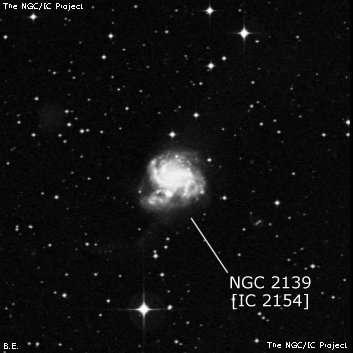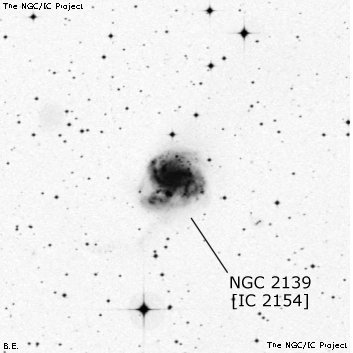NGC/IC Project Restoration Effort
(This is a very very beta version)
NGC2139


Basic Information
Location and Magnitude
Right Ascension: 6:1:8.0
Declination: -23:40:22
Constellation: LEP
Visual Magnitude: 11.6
Historic Information
Discoverer: Herschel W.
Year of discovery: 1784
Discovery aperture: 18.7
Observational
Summary description: F, S
Sub-type: SBc
Corwin's Notes
=====
NGC 2139 = IC 2154. Dreyer has a note in his 1912 edition of WH's Scientific
Papers on this object. Taken from WH's note in the sweep, it reads "The A.R.
cannot be above 10 or 15 s out; the roller went off the apparatus which
occasions the uncertainty." The RA is actually 24 seconds out, and the dec,
due to another unspecified error, is 8.5 arcmin off. Dreyer was further able
to identify a star in the sweep that was closer to the galaxy than WH's
"official" reference star, delta Canis Majoris. Comparison with this star led
to the correct position.
However, he had not yet done this when Howe and Bigourdan tried to find the
NGC object near WH's place -- not surprisingly, neither succeeded. What is
surprising is that when Lewis Swift came across the galaxy over a century
after WH, he did not make as nearly as large an error in its position as WH.
Swift's positions from his last nights in 1897 and 1898 at Lowe Observatory on
Echo Mountain are nortoriously bad. But for this object, he actually came
within 14 seconds in RA and 1 arcmin in Dec. Herbert Howe pinned the galaxy
down with a micrometric observation and it was that position that Dreyer
adopted for IC 2154. Dreyer himself discovered the identity when he fixed
WH's position for the NGC object.
Steve's Notes
=====
NGC 2139
17.5" (12/8/90): moderately bright, moderately large, slightly elongated, broad concentration, core appears offset to the northwest of center. A mag 14 star is at the north edge 1.3' from center and a mag 11 star lies 3.5' SSE.
8" (1/1/84): faint, fairly small, round, broad concentration. A mag 11 star is 4' SSE.



